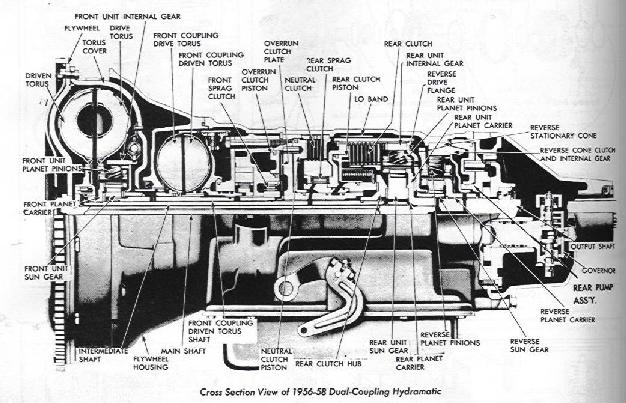
Jetaway transmissions, Transmissions for sale
Getting power from the engine to the drive wheels of an automobile has provided an endless challenge for rear-wheel-drive, front-wheel-drive, 4-wheel-drive, AWD, front-engine, rear-engine, and mid-engine cars, longitudinal, transverse, vertical, slant, and flat engines, plus an amazing array of hardware in between. George Selden’s notorious 1877 patent was for a front-drive carriage with a transverse 3-cylinder engine, anticipating the Chevy/Suzuki Sprint by over a century. When it comes to car designs, there are very few new ideas, just progressively successful adaptations of old concepts.
The heart of the drivetrain is the transmission. Because gasoline engines develop their torque over a very narrow speed range, several gears are needed to reach useful road speeds. (Steam engines and electric motors can be used in cars with no transmissions.)
The modern transmission was introduced by a pair of Frenchmen, Louis-Rene Panhard and Emile Levassor, in 1894. The engineers had invited the press to a demonstration of the most revolutionary advancement to date in the brief history of the motor car industry. Unfortunately, the engine in their demo vehicle died, and they were reduced to giving a chalk talk on multi-geared transmission theory to a bored press corps.
Cars of the time transmitted engine power to the wheels in a simple fashion that was easy for non-engineers to visualize. The engine drove a set of bevel reduction gears that drove a shaft and pulley. Leather belts extended between the pulley and geared wheels on an axle. One wheel, the small one, got the car going by meshing with a ring gear on one of the driving wheels. The big wheel then took over to get the car to hustle along at a top speed of 20 mph. If the car encountered a hill that it did not have the power to climb, the driver would come to a dead stop so he could engage the small wheel.
Descriptions of the transmissions in these cars: One belt-driven high gear that will go over everything and one belt-driven Low gear in case the car had to climb a tree.
That 1895 Panhard-Levassor was revolutionary, not the transmission alone, but the whole drivetrain layout. In fact, it has served as the prototype for most vehicles built in the 90 years since then. Unlike other cars of that day, it possessed a vertically mounted engine in the front of the vehicle that drove the rear wheels through a clutch, 3-speed sliding gear transmission and chain-driven axle. The only modern features missing from the setup were a differential rear axle and driveshaft. These came along three years later, in 1898, when millionaire-turned-auto-hobbyist Louis Renault connected a vertical engine with transmission to a “live” rear axle by means of a metal drive shaft.
The live rear axle, which Renault adapted from an idea developed in 1893 by an American, C. E. Duryea — was called the differential, or rear axle. It used a number of gears to overcome the problem of rapid tire wear, which was most destructive on turns with the “dead” axles used by all other carmakers. “Differential” referred to the ability of the unit to turn the outer driving wheel faster than the inner driving wheel, eliminating tire scuffing in turns.
By 1904, the Panhard-Levassor sliding gear manual transmission had been adopted by most carmakers. In one form or another, it has remained in use until recent times. Obviously, there have been improvements, the most significant being the invention of a synchronizing system that permits drive and driven gears to be brought into mesh with each other smoothly without gear clashing. The first of these synchromesh transmissions was introduced by Cadillac in 1928. An improvement to the design patented by Porsche is widely used today.
Between the time the sliding gear-transmission was introduced and the perfection of the synchromesh, there were other attempts at making it easier for the driver to shift gears. One was the planetary transmission in the 1908 Model T Ford. It had a central gear, called the “sun” gear, surrounded by three “planet” gears. Today, planetary gears are more widely used in automatic transmissions than in manual.
Some pretty elaborate planetary manual transmissions did evolve, however. One was developed by Walter Wilson and was called the Wilson Preselector. It came along in 1930.
This gear system, which used four individual planetary gearsets, allowed the driver to preselect one gear ratio by moving a small lever on the steering column. the driver could then engage the particular preselected gear by depressing a foot pedal.
All transmission designs since the Panhard-Levassor unit have had one goal in common — to make shifting easier. Obviously, the easiest to shift transmission is the automatic. It’s strictly an American innovation.
The first automatic was invented in 1904 by the Sturtevant brothers of Boston. It provided two forward speeds that were engaged and disengaged by the action of centrifugal weights without need for a foot-operated clutch. As engine speed increased, the weights swung out to engage bands — first the low-gear band and then the high-gear band. The unit failed because the weights often flew apart.
The next significant attempt at an automatic transmission was by Reo in 1934. Called the Reo Self-Shifter, it was actually two transmissions connected in series. For ordinary driving, one unit upshifted itself automatically in relation to car speed through the engagement of a centrifugal multiple-disc clutch — much the same idea used by the Sturtevants. The second transmission was shifted manually and was used only when a lower gear was needed.
In 1937, Buick and Oldsmobile came out with a transmission called the Automatic Safety Transmission. It had a conventionally clutch for shifting the transmission into forward or reverse. Once in forward, the transmission shifted automatically by using two hydraulically operated planetary units — one for low gear and one for drive. The unit was the forerunner of the GM Hydra-Matic, which was born in 1938.
The Hydra-Matic consisted of three planetary gearsets that were operated hydraulically. A fluid coupling was used to connect the engine and transmission. Credit for perfecting the fluid coupling goes to Chrysler, which developed the concept in 1937. However, Chrysler did not make use of it until 1941, when the Chrysler Fluid Drive transmission was introduced. This was not an automatic unit, but a standard transmission with a fluid coupling, not a clutch.
By 1948, the automatic transmission had evolved into the hydraulic torque converter that we know today coupled to a planetary geartrain. The first to use the converter was Buick. The ’48 Buick Dynaflow, as it was called, was the model for present-day automatic transmissions. Others soon followed with similar units — Chevrolet Powerglide, Fordomatic and Merc-O-Matic in 1950; and the Chrysler M-6 Torque Converter Automatic in 1951.
The end of this article will be posted in the next few days, stay tuned or get yourself a free subscription. For information on matters like buying transmissions, we have a well trained staff waiting to hear from you. GotTransmissions.com Call @ 866-320-1182


